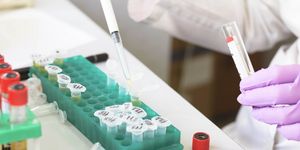You may have never heard of a parasitic disease called schistosomiasis, but over 75 million people required treatment, and over 251 million people had to take preventive treatment for the disease in 2021 alone, according to the World Health Organization. People are infected by water that is contaminated with parasitic flatworms; when the water is consumed or permeates the skin, the larvae in the water hatches into adult worms once inside the body. Schistosomiasis is both an acute and chronic disease that causes abdominal pain, diarrhea, and bloody stool. Later stages can lead to liver enlargement, blood in urine, genital lesions, and kidney and bladder damage; there can be long-term consequences such as infertility. Right now, it's thought that at least 11,000 people die from the disease every year, but this count may be underestimated.

Scientists have now found a new way to identify this disease, which is currently diagnosed with microscopy, a method that requires technicians who are trained on special equipment. Because the disease primarily affects impoverished areas, this diagnostic technique can pose a serious burden for clinicians and patients.
The Schistoscope has now been created to improve diagnostic options. This optical tool autofocuses so slides carrying urine samples can be assessed automatically. This technology detects Schistosoma haematobium eggs, which are frequently a cause of urogenital schistosomiasis. A two-stage diagnostic process involving identify and quantifying these eggs has now been reported in the Journal of Medical Imaging.
The tool was developed using samples collected in the field. The researchers carefully differentiated between the eggs and artifacts in the slides like debris, bubbles, fibers, or crystals that can all interfere with accurate diagnoses. Software was created and trained to first identify the eggs in a sample, and next, count how many there are. The researchers said that this two-stage process will make accurate egg counts.
Once developed, the technology was tested using 65 clinical samples. The automatic tool was able to make egg counts that closely agreed with those made by people who are experts at diagnosing schistosomiasis.
"By automating the egg detection process, the Schistoscope and the proposed diagnostic framework offer a promising solution for the rapid and accurate diagnosis of urogenital schistosomiasis, particularly in low-resource settings," said corresponding study author Professor Jan Carel Diehl, of Delft University of Technology.
Now the researchers are working on performing additional validation tests and comparing it to other methods like DNA assays and antigen detection that are also used to diagnose schistosomiasis.
Sources: SPIE, Journal of Medical Imaging


